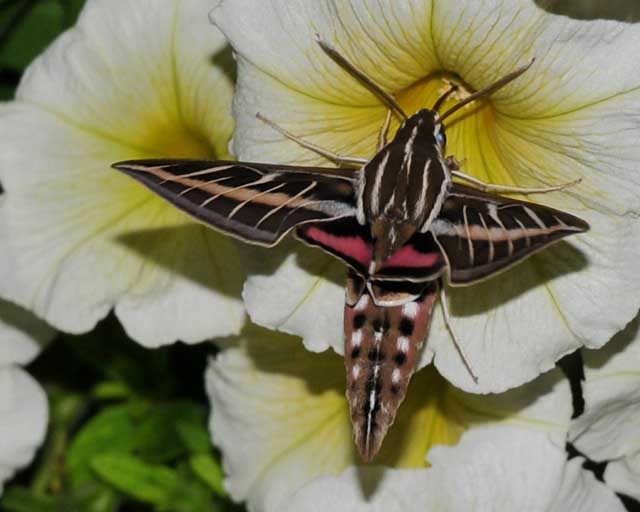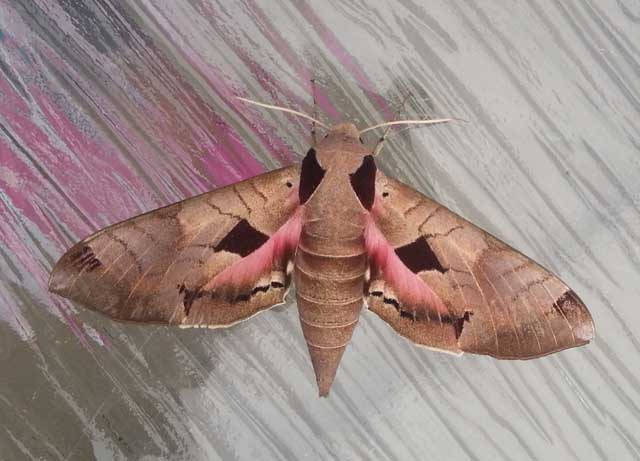Sphinginae subfamily
Sphingini tribe:
 |
Agrius cingulata
as a stray only,
Pink-spotted Hawkmoth
stray
This moth is a very strong flier, but would only make its way to
Manitoba as a rare stray.
|
 |
Ceratomia amyntor,
the Elm Sphinx or Four-horned Sphinx:
The upperside of the forewing is brown with dark brown and white markings including a white costal area near the wing base, dark streaks along the veins,
and a white spot in the cell. southern half of Manitoba
|
 |
Ceratomia catalpae
stray,
the Catalpa Sphinx:
The upperside of the forewing is yellowish brown with no white markings, but there are indistinct black lines and dashes. The cell spot is gray with a black outline. The larvae feed in large groups and are much more
spectacular than the moths.
Catalpa is the larval host.
might be a casual breeder in southeastern Manitoba |
 |
Ceratomia undulosa
abundant, the Waved
Sphinx: The upperside of the forewing is pale brownish gray with wavy black
and white lines and a black-outlined white cell spot. The upperside
of the hindwing is gray with diffuse darker bands. southern half
|
 |
Lapara bombycoides,
Northern Pine Sphinx:
The upperside of the forewing is gray with heavy black bands. The upperside of the hindwing is brownish gray with no markings.
If you have pines, you probably have this species.
|
 | The upperside of the forewing is gray-brown with wavy lines, black
dashes, and one or two small white spots near the center of the costa.
Southeastern Manitoba only.
|
 |
Manduca quinquemaculatus,
Five-spotted Hawkmoth:
Abdomen usually has five but sometimes six pairs of yellow
bands. Fw upperside: blurry brown and gray.
I suspect if you grow tomatoes, you are likely to encounter it in extreme southwestern Manitoba.
|

|
Sphinx canadensis,
Sphinx canadensis, the Canadian Sphinx, is not common, and is not
often reported anywhere.
Larval hosts are white ash (Fraxinus americana) and blueberry
(Vaccinium). southeast
|
 |
Sphinx chersis, the Northern Ash Sphinx or
Great Ash Sphinx: This species is present and is probably common.
Larval hosts are ash, lilac, privet, cherry, and quaking
aspen. southern fifth
|
 |
Sphinx drupiferarum,
Wild Cherry Sphinx: Fw: dull slate grey with considerable light grey scaling in broad band along costa about 3/4 of distance from body toward apex.
Median lines: black, thin. Wavy, diffuse dark subterminal line, inwardly bordered by white, and whitish bar in terminal area, paralleling outer margin.
southern half of Manitoba
|
 |
Sphinx gordius
probably poecila, the
Apple Sphinx
The upperside of the forewing ranges from brown with black borders
through brownish gray with paler borders to pale gray with no
borders. southern quarter |
 |
Sphinx poecila
WO, Poecila Sphinx: FW fringes checkered black and white, almost pure white (lightly checked with grey) on HW.
FW dark gray with diffuse black, gray wavy lines with series of black dashes ending at wing tip,
and white cell spot which readily distinguishes poecila from canadensis. HW brownish gray
with wide black border, black median line.
|
 |
The lower forewings are predominantly brownish-yellow with a fairly
wide dark bar along the inner margin. At rest the wings hug the body,
giving the moth a long slender look. siouthern quarter
|
 |
Sphinx luscitiosa ,
Canadian Sphinx; Clemen's Sphinx: Fw upperside: yellowish gray in males; pale gray with faint yellow tint in females.
Dark border on outer margin widens as
it approaches i. m.. Hw upperside: deep yellow in males, pale yellow in females; both with wide black border.
|
 |
Sphinx poecila
abundant, the Poecila Sphinx
If you have blueberries in the woods, then you might have the
Poecila Sphinx.
They are pretty common here on Prince Edward Island. widespread
|
 |
Sphinx vashti
WO?, Snowberry Sphinx:
Snowberry Sphinx adults fly as a single brood in montane woodlands and along prairie
streamcourses from April to August.
Fw upperside: narrow black subterminal line
bordered by white inverted V-shaped line on outside, and
black line at apex. extreme southwest only |
Smerinthini Tribe:
 |
Amorpha juglandis
common,
the Walnut Sphinx:
The adults are also highly variable; sometimes wings of an individual
may be all one color or may have several colors, ranging from pale to
dark brown, and may have a white or pink tinge.
See the file for the female; she is different.
|
 |
Pachysphinx modesta
common,
the Modest Sphinx or Poplar Sphinx
This moth is recorded regularly in Ontario. Its larvae are
fond of poplars and
willows.
at least as far north as The Pas.
They are common on Prince Edward Island.
|
 |
Named for the dull grey-blue spot (minus dark pupil) in the hindwing,
this moth has a wide distribution and is common in Ontario.
I regularly see them on Prince Edward Island, and they are reported
as far south as Florida. |
 |
Paonias myopscommon, the Small-eyed Sphinx
Named for the small eye-spot in the hindwing, this moth has a wide
distribution and is probably common in Ontario.
I regularly see them on Prince Edward Island, and they are reported
as far south as Florida.
|
 |
Smerinthus cerisyi
common,
the Cerisyi's Sphinx
Smerinthus cerisyi is found in the southern regions of all Canadian
provinces and in northern border states. The one-eyed sphinx is also
found along the U.S. west coast, eastward to the Rockies. At my home
in Montague, P.E.I., Canada, they are quite common.
|
 |
Smerinthus jamaicensis
common,
the Twin-spotted Sphinx:
This moth is widely distributed and fairly common.
Along the East Coast, it flies from P.E.I. to Florida. I suspect it
is present. |
Macroglossinae subfamily
Dilophonotini tribe:
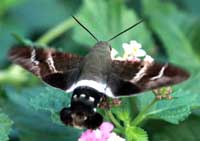 |
Aellopos titan
rare migrant, stray, the Titan Sphinx.
possible stray
The body is dark brown with a wide white stripe across the abdomen.
The wings are dark brown. The
upperside of the hindwing has
pale patches along the costa and inner margin. |
See Hemaris comparison to help distinguish
the next four species.
 |
Hemaris thysbe
common, the Hummingbird Clearwing
It is not difficult to see why many gardeners would mistake an
Hemaris thysbe moth for a small hummingbird as it hovers,
sipping nectar from flowers through a long feeding tube. widespread
|
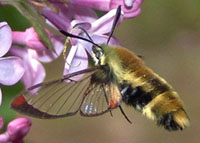 |
Hemaris aethra
common.
Note large orangey-brown forewing apical patch. In very similar H. diffinis patch is smaller.
On average H. aethra, compared to H. diffinis, tends to be slightly larger, with more orangey-yellow tone,
less tapering (top to bottom) of dark thorax/abdominal region; more red nr hw anal angle.
|
 |
Hemaris diffinis
common, the
Snowberry Clearwing or Bumblebee Moth
Adults mimic bumblebees and are quite variable. The wings are
basically clear, with dark brown to brownish-orange veins, bases
and edges. The thorax is golden-brown to dark greenish-brown with
1-2 yellow segments on the abdomen. southern half
|
 |
Hemaris gracilis
present, the
Slender Clearwing or Graceful Clearwing
This day-flying moth is less common. widespread
|
Philampelini tribe:
 |
Eumorpha achemon
rare, extreme south,
the Achemon Sphinx:
Note the differences between this moth and the Pandorus Sphinx (not reported thus far in Manitoba).
|
Eumorpha achemon, Brandon, August 10, 2013, Tina August
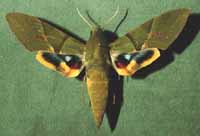 |
Eumorpha labruscae
the Gaudy Sphinx:
The Gaudy Sphinx flies in America, and although primarily a tropical
species, it has been taken as far north as Saskatchewan and Manitoba as a stray.
Forewings are a vibrant grey-green.
|
Macroglossini tribe:
 |
If you have Virginia Creeper,
you probably have the Nessus Sphinx.
Two bright, distinct, narrow yellow
bands are often visible on the abdomen. southeastern
|
 |
They are common in New Jersey and common
here on Prince Edward Island.
You will often see this species listed as Darapsa pholus,
especially in older literature.
It is confirmed for Ontario. southern third
|
 |
Darapsa myron
present, the Virginia Creeper Sphinx or the
Grapevine Sphinx
It is widely reported as far north as southern Maine. If you have the
foodplants indicated in the common names, you probably have this
species nearby. south central |
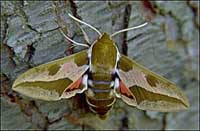 |
Hyles euphorbiae
introduced,
the Leafy Spurge Hawkmoth
This species has been introduced into Ontario to try to control
the spread of leafy spurge. southern
|
 |
Hyles gallii, the Bedstraw Hawk Moth
or Gallium Sphinx
This species is reported in Ontario.
Some years I see them on P.E.I., some years, I do not. widespread
|
 |
Hyles lineata
irregular migrant, the White-lined Sphinx:
This species is reported from Manitoba. It flies across
southern New York and has strong migrating tendancies.
There are records from New Hampshire and Maine. extreme south |
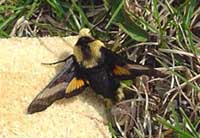 |
This day flier is officially reported from Ontario, but it
maynot be common. Look for them in meadows near coniferous forests. widespread
|
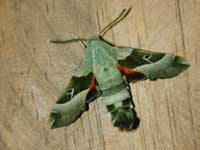 |
Proserpinus juanita,
Juanita Sphinx:
The upperside of the forewing is pale gray-green with a deep
green-brown median area and a white dash at the wing tip.
extreme southwest
|
 |
Sphecodina abbottii
only larvae reported thus far,
the Abbott's Sphinx
This moth is very much under reported across the United States
and canada. It
is a rapid day flier so is probably not in too many collections.
Grape is a popular larval host.
|
|
|
